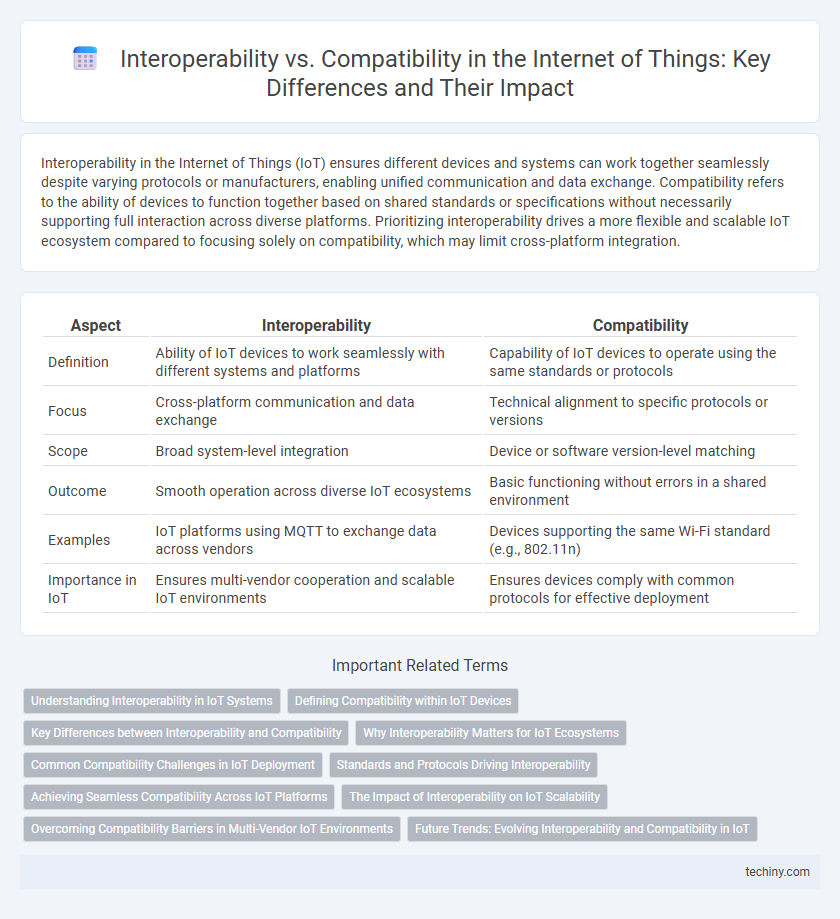Interoperability in the Internet of Things (IoT) ensures different devices and systems can work together seamlessly despite varying protocols or manufacturers, enabling unified communication and data exchange. Compatibility refers to the ability of devices to function together based on shared standards or specifications without necessarily supporting full interaction across diverse platforms. Prioritizing interoperability drives a more flexible and scalable IoT ecosystem compared to focusing solely on compatibility, which may limit cross-platform integration.
Table of Comparison
| Aspect | Interoperability | Compatibility |
|---|---|---|
| Definition | Ability of IoT devices to work seamlessly with different systems and platforms | Capability of IoT devices to operate using the same standards or protocols |
| Focus | Cross-platform communication and data exchange | Technical alignment to specific protocols or versions |
| Scope | Broad system-level integration | Device or software version-level matching |
| Outcome | Smooth operation across diverse IoT ecosystems | Basic functioning without errors in a shared environment |
| Examples | IoT platforms using MQTT to exchange data across vendors | Devices supporting the same Wi-Fi standard (e.g., 802.11n) |
| Importance in IoT | Ensures multi-vendor cooperation and scalable IoT environments | Ensures devices comply with common protocols for effective deployment |
Understanding Interoperability in IoT Systems
Understanding interoperability in IoT systems involves enabling diverse devices and platforms to communicate and work seamlessly together, regardless of manufacturer or protocol differences. Interoperability ensures data exchange, integration, and collaborative functionality across heterogeneous networks, enhancing system efficiency and scalability. Unlike compatibility, which implies basic coexistence, interoperability emphasizes active interaction and synchronized operation within complex IoT ecosystems.
Defining Compatibility within IoT Devices
Compatibility within IoT devices refers to their ability to function seamlessly together without requiring modifications, often relying on shared communication protocols and standards. It ensures that hardware and software components can operate in harmony, enabling efficient data exchange and command execution across diverse devices. Defining compatibility is critical for reducing integration costs, enhancing user experience, and promoting scalable IoT ecosystems.
Key Differences between Interoperability and Compatibility
Interoperability in the Internet of Things (IoT) refers to the ability of diverse devices and systems to communicate, exchange data, and operate together seamlessly regardless of manufacturer or platform. Compatibility focuses on the capacity of devices to work within the same system or environment, often requiring shared standards or technologies to function correctly. Key differences lie in interoperability enabling cross-platform integration and dynamic interaction, while compatibility ensures basic functional alignment within predefined setups.
Why Interoperability Matters for IoT Ecosystems
Interoperability ensures seamless communication and data exchange between diverse IoT devices and platforms, enabling a cohesive and efficient ecosystem. Unlike compatibility, which often limits interaction to specific devices or protocols, interoperability promotes scalability and innovation by supporting cross-vendor integration. This capability is critical for driving widespread IoT adoption and unlocking the full potential of connected smart environments.
Common Compatibility Challenges in IoT Deployment
Common compatibility challenges in IoT deployment include device heterogeneity, disparate communication protocols, and inconsistent data formats that hinder seamless integration. Lack of standardized interfaces and proprietary technologies further complicate interoperability among connected devices and platforms. Addressing these issues requires adopting universal standards and middleware solutions to enable cohesive device communication and data exchange.
Standards and Protocols Driving Interoperability
Standards and protocols like MQTT, CoAP, and Zigbee are pivotal in driving interoperability across diverse Internet of Things (IoT) devices by enabling seamless communication and data exchange. Interoperability goes beyond compatibility by ensuring that devices from different manufacturers work together harmoniously within an ecosystem through standardized frameworks. Adherence to open standards like IEEE 802.15.4 and industry consortia initiatives accelerates cross-platform integration and scalability in IoT deployments.
Achieving Seamless Compatibility Across IoT Platforms
Achieving seamless compatibility across IoT platforms requires addressing both interoperability and compatibility issues by standardizing communication protocols, data formats, and device interfaces. Interoperability ensures diverse IoT devices from various manufacturers can exchange and interpret data effectively, while compatibility guarantees that hardware and software components function together without conflicts. Leveraging open-source platforms and adopting universal IoT standards such as MQTT, CoAP, and OPC UA accelerates device integration and enhances system scalability.
The Impact of Interoperability on IoT Scalability
Interoperability drives IoT scalability by enabling diverse devices and platforms to seamlessly communicate and function together, fostering an expansive and flexible network architecture. Unlike compatibility, which often limits interactions to predefined standards or specific ecosystems, interoperability supports dynamic integration across various manufacturers and technologies, accelerating deployment and innovation. Enhanced interoperability reduces costs and complexity in scaling IoT solutions, allowing for more efficient data exchange and system expansion essential for robust smart environments.
Overcoming Compatibility Barriers in Multi-Vendor IoT Environments
Interoperability in multi-vendor IoT environments enables seamless data exchange and functionality across diverse devices and platforms, surpassing mere compatibility that often limits communication to basic hardware or software alignment. Overcoming compatibility barriers involves adopting standardized protocols, open APIs, and middleware solutions that facilitate integration and ensure cohesive operation among heterogeneous IoT components. Emphasizing interoperability enhances scalability, reduces integration costs, and drives innovation by enabling diverse IoT systems to work together harmoniously.
Future Trends: Evolving Interoperability and Compatibility in IoT
Future trends in IoT emphasize evolving interoperability frameworks that enable seamless communication across diverse devices and platforms, leveraging standardized protocols and AI-driven middleware solutions. Compatibility advancements focus on adaptive firmware updates and modular hardware designs to ensure long-term functionality amid rapid technological changes. These developments collectively drive more resilient, scalable, and user-centric IoT ecosystems.
Interoperability vs Compatibility Infographic

 techiny.com
techiny.com